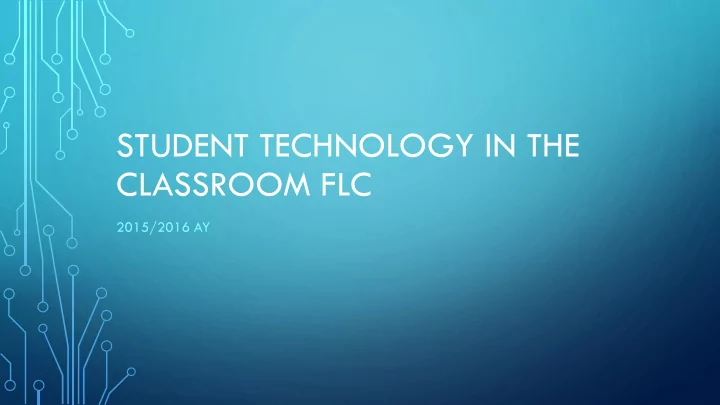

STUDENT TECHNOLOGY IN THE CLASSROOM FLC 2015/2016 AY
WHO WE ARE • Our names • Tiffany Gierasch, Milvia Hernandez, Tomoko Hoogenboom, Yi Huang, Tracy Irish, Christine Mallinson, Carole McCann, Laura Rose, Donald Snyder, Liz Stanwyck • Our roles • Lecturer, professor, clinical instructor, chair, coordinator • Our departments • Chemistry and Biochemistry; Education; Gender and Women’s Studies; Language, Literacy and Culture; Mathematics and Statistics; Media and Communication Studies; Modern Languages, Linguistics and Intercultural Communication; Psychology
WHY A WHITE PAPER? • Common themes appeared during FLC meetings • Technology students can be expected to bring to class, difficulties with borrowing technology, support for faculty to learn new technology, classroom barriers to technology use, how to communicate about it all • To share our discoveries with the entire campus community • Diverse perspectives (disciplines, technology-expertise levels, faculty roles, class sizes) • Give a “state of the campus” assessment in terms of technology and resources • Recommend policies to support the growing role of technology in higher education at UMBC
FLCS FOCUSED ON TECHNOLOGY • 21 st Century Literacies: Developing and Implementing Digital Assignments • Using emerging technology to challenge students to enhance, reflect upon, and demonstrate knowledge • iTeach: Using Tablet Computers in the Classroom • Sharing how tablets can become valuable assets in courses (planning, content delivery, creative production) • Incorporating Student Technology in the Classroom • Incorporating student technology devices into lessons and lectures; finding ways to turn potential distractions into classroom strengths
PEDAGOGICAL STRATEGIES (SOME EXAMPLES) • Online coursework for students to access • mastery assignments, discussion boards, videos with quizzes, online assignments and tutorials, and ebooks • Student use of technology to complete coursework • wikis, blogs, journals, data analysis, social media for information dissemination, memes, infographics, podcasts, and movies • Faculty use of technology • clickers, virtual office hours, videos, tablets in the classroom, online trivia websites, reading guides, creation of paperless course materials
TECHNOLOGY ON CAMPUS: CHALLENGES • Limited opportunities for faculty to meet, plan, and develop teaching strategies (FLCs are one such opportunity!) • Limited institutional support • for technical challenges, hardware and software purchases, development of multimedia communication skill-building, implementation of technology in faculty lessons and student coursework • Lack of written guidelines • to fairly evaluate and reward faculty who develop technological tools for pedagogical purposes • Limited technological infrastructure in classrooms • Does not allow networking student computers, projecting student work, sharing student work digitally, allowing students to work in groups/rearrange room
SURVEY OF TECHNOLOGY-RELATED INITIATIVES, SUPPORT, AND TRAINING ON CAMPUS • Faculty Development Center (FDC) • Provides infrastructural support for the development and implementation of pedagogical innovation and experimentation • New Media Studio (NMS) • Helps campus community apply emerging media technologies in teaching, learning, and creative endeavors • Albert O. Kuhn Library (AOK) • Provides multifaceted support for technology-enhanced teaching and learning • Division of Information Technology • A primary resource for consulting on technology-related issues • Other campus initiatives • Dresher Center, iCubed, CASTLE, Discovery Center, ACTIVE Center, CWIT, etc.
POLICY RECOMMENDATIONS • Recognize Faculty Learning Communities as an important vehicle for faculty engagement across campus and a mechanism to shape campus policy • Add the Classroom Planning Committee to the standing list of Faculty Senate committees with faculty representation • Develop a Central Warehouse to contain all the relevant campus-wide information about technology on campus • Recognize the need for improvements to Classroom Infrastructure • Classroom makeovers • Technology Teaching Lab • Recognize the need for improvements in Technical Assistance • Pedagogy technicians • Funding to broaden student access to visual tools • Funding to collaborate with NMS to build and maintain a website of tools and resources
Recommend
More recommend